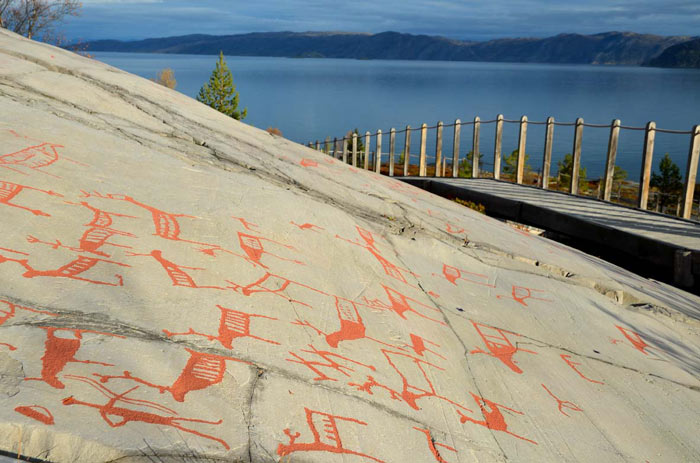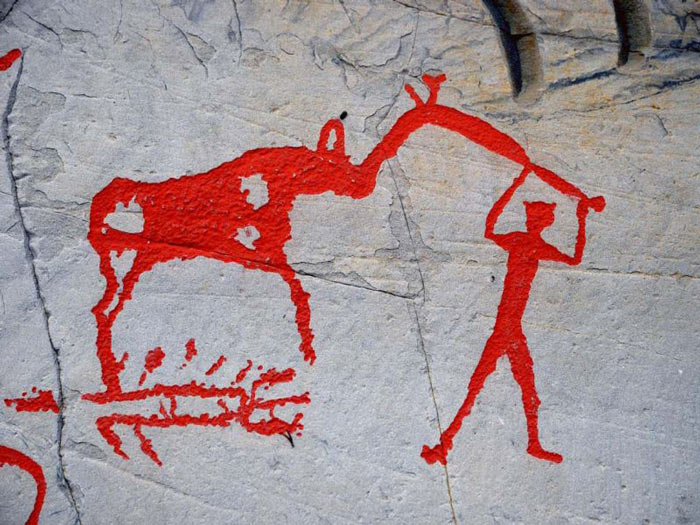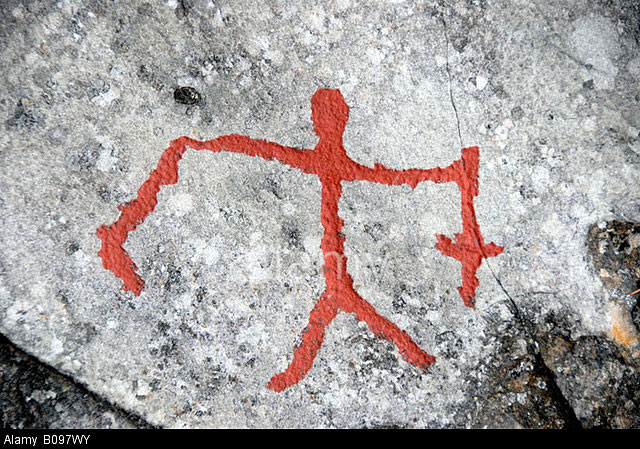Stone carvings in Alta - Norway
Unesco Scientific, Educational and Cultural Organization has recognized Norway's Alta stone carvings as a World Cultural Heritage in 1985.
The stone carvings of Alta are located in an archaeological site in Finnmark Province, Northern Norway, close to the Arctic Circle. These carvings were discovered in June 1973, since then many search surveys have been carried out and there have been more carvings in the surrounding area found.

Most of the carvings here have themes about animals such as reindeer, elk, bears, dogs, wolves, weasels, rabbits, ducks, swans, cormorants, salmon, whales . One the number of etchings depicting human activities such as fishing boats, hunting and fishing scenes . There are also images of rituals, worship, dancing, and ceremonies. Archaeologists say that the rituals described by stone carvings may be of Shamanism followers.



 Stone carvings depict the living labor of prehistoric people in Alta, Norway.The carvings show that people thousands of years ago lived by hunting, gathering and fishing.
Stone carvings depict the living labor of prehistoric people in Alta, Norway.The carvings show that people thousands of years ago lived by hunting, gathering and fishing.
Through many surveys and statistics, scientists have summarized more than 5,000 inscriptions in this archaeological site. More than 5,000 carvings were engraved on 60 scattered cliffs in 5 different areas including: Hjemmeluft, Storsteinen, Amtmannsnes, Kafjord and Transiarelvdalen. Among them at Hjemmeluft (samisk: Jiepmaluokta), about 5km from Alta city center, there were at least 3,000 carvings. There is an open-air museum set up by the Norwegian government. The museum is not only a place to store and preserve stone carvings but also create conditions for interested people to come and learn. The outdoor museum is managed by Professor Knut Helskog at Trome University and collects artifacts from the first days. Although he was not the one who discovered the stone carvings, Professor Knut Helskog was the one who had great merits in collecting and analyzing artifacts for the museum.

 A small number of carvings depict traditional rituals and practices of the people
A small number of carvings depict traditional rituals and practices of the people
In June 1973, a local farmer and his son on a fishing trip accidentally discovered a caribou carvings. After that many people in the area came here and discovered more other carvings. Therefore, they reported to Tromso University and Professor Knut Helskog quickly came here to study and learn. Most of the current artifacts and studies are preserved by the contributions of professors and their associates.

According to research records, the stone carvings in Alta were engraved between 4.200 and 500 BC. Some suggested that these carvings continued to be carved centuries later in the sixth century AD to truly stop. The owner of these engravings is that of a tribe living mainly by hunting animals and fishing. They have traditional rituals and their custom.

The Alta stone carvings of Norway are recognized by the Unesco as a World Cultural Heritage by criterion (iii): The stone carvings in Alta with more than 5,000 carvings are testimonies, a story about a nation living by hunting, gathering, fishing in the Arctic region from prehistoric times. The variety of patterns and the way of drawing art quality in drawings dating back thousands of years shows the development of thinking, as well as the artistic feel of society from about 5000 years ago. AD

- Brazil discovered a 10,000-year-old stone carvings
- Mysterious carvings on stone
- Scientists found a Buddha image carved in stone in Siberia
- Mysterious prehistoric stone carvings in Scotland
- The carving depicts the oldest description of a supernova
- Discovering stone carvings of 2.6 million years old
- Discover the most ancient mysterious carvings of North America
- Display the 2,000-year-old stone carvings written in the name 'Jerusalem' in Hebrew
- Stone carvings in Valcamonia - Italy
- Mysterious carvings on ancient stones only appear in the moonlight
- Stone carvings
- Real paradise in rural Norway
 Suzhou classic bonsai garden - China
Suzhou classic bonsai garden - China Chau Nguyen Dynasty
Chau Nguyen Dynasty Thai Son Mountain - World Wonder
Thai Son Mountain - World Wonder Ancient villages of Shirakawa-go and Gokayama
Ancient villages of Shirakawa-go and Gokayama